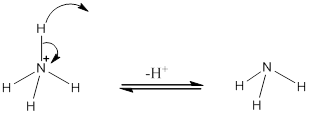
(a)
Interpretation:
Conjugate bases of given acids are needed to be drawn.
Concept introduction:
According to Bronsted-Lowry concept, acid is a proton donor. The deprotonated acids are called conjugate base. The stability of this conjugate base determines the location of deprotonation in an acid.

In a conjugate base where the negative charge is carried by a more electronegative atom will show more stability. The greater electronegativity makes lone pair closer to the nucleus hence more stabilized.
The conjugate base having resonance will have greater stability as compared to conjugate base having single anion. Because of the resonance conjugate base will get resonance stabilization.
(a)
Answer to Problem 34PP

Explanation of Solution

The most acidic proton of the given acid (a) is
(b)
Interpretation:
Conjugate bases of given acids are needed to be drawn.
Concept introduction:
According to Bronsted-Lowry concept, acid is a proton donor. The deprotonated acids are called conjugate base. The stability of this conjugate base determines the location of deprotonation in an acid.

In a conjugate base where the negative charge is carried by a more electronegative atom will show more stability. The greater electronegativity makes lone pair closer to the nucleus hence more stabilized.
The conjugate base having resonance will have greater stability as compared to conjugate base having single anion. Because of the resonance conjugate base will get resonance stabilization.
(b)
Answer to Problem 34PP

Explanation of Solution
The most acidic hydrogen atom presented in the given acid is
 .
.
No other
(c)
Interpretation:
Conjugate bases of given acids are needed to be drawn.
Concept introduction:
According to Bronsted-Lowry concept, acid is a proton donor. The deprotonated acids are called conjugate base. The stability of this conjugate base determines the location of deprotonation in an acid.

In a conjugate base where the negative charge is carried by a more electronegative atom will show more stability. The greater electronegativity makes lone pair closer to the nucleus hence more stabilized.
The conjugate base having resonance will have greater stability as compared to conjugate base having single anion. Because of the resonance conjugate base will get resonance stabilization.
(c)
Answer to Problem 34PP

Explanation of Solution
Deprotonation of

(d)
Interpretation:
Conjugate bases of given acids are needed to be drawn.
Concept introduction:
According to Bronsted-Lowry concept, acid is a proton donor. The deprotonated acids are called conjugate base. The stability of this conjugate base determines the location of deprotonation in an acid.

In a conjugate base where the negative charge is carried by a more electronegative atom will show more stability. The greater electronegativity makes lone pair closer to the nucleus hence more stabilized.
The conjugate base having resonance will have greater stability as compared to conjugate base having single anion. Because of the resonance conjugate base will get resonance stabilization.
(d)
Answer to Problem 34PP

Explanation of Solution
Deprotonation of

(e)
Interpretation:
Conjugate bases of given acids are needed to be drawn.
Concept introduction:
According to Bronsted-Lowry concept, acid is a proton donor. The deprotonated acids are called conjugate base. The stability of this conjugate base determines the location of deprotonation in an acid.

In a conjugate base where the negative charge is carried by a more electronegative atom will show more stability. The greater electronegativity makes lone pair closer to the nucleus hence more stabilized.
The conjugate base having resonance will have greater stability as compared to conjugate base having single anion. Because of the resonance conjugate base will get resonance stabilization.
(e)
Answer to Problem 34PP

Explanation of Solution
The most acidic proton of the given acid (e) is

(f)
Interpretation:
Conjugate bases of given acids are needed to be drawn.
Concept introduction:
According to Bronsted-Lowry concept, acid is a proton donor. The deprotonated acids are called conjugate base. The stability of this conjugate base determines the location of deprotonation in an acid.

In a conjugate base where the negative charge is carried by a more electronegative atom will show more stability. The greater electronegativity makes lone pair closer to the nucleus hence more stabilized.
The conjugate base having resonance will have greater stability as compared to conjugate base having single anion. Because of the resonance conjugate base will get resonance stabilization.
(f)
Answer to Problem 34PP

Explanation of Solution
The most acidic proton of the given acid (e) is
(g)
Interpretation:
Conjugate bases of given acids are needed to be drawn.
Concept introduction:
According to Bronsted-Lowry concept, acid is a proton donor. The deprotonated acids are called conjugate base. The stability of this conjugate base determines the location of deprotonation in an acid.

In a conjugate base where the negative charge is carried by a more electronegative atom will show more stability. The greater electronegativity makes lone pair closer to the nucleus hence more stabilized.
The conjugate base having resonance will have greater stability as compared to conjugate base having single anion. Because of the resonance conjugate base will get resonance stabilization.
(g)
Answer to Problem 34PP

Explanation of Solution
Deprotonation of

Want to see more full solutions like this?
Chapter 3 Solutions
Organic Chemistry
 ChemistryChemistryISBN:9781305957404Author:Steven S. Zumdahl, Susan A. Zumdahl, Donald J. DeCostePublisher:Cengage Learning
ChemistryChemistryISBN:9781305957404Author:Steven S. Zumdahl, Susan A. Zumdahl, Donald J. DeCostePublisher:Cengage Learning ChemistryChemistryISBN:9781259911156Author:Raymond Chang Dr., Jason Overby ProfessorPublisher:McGraw-Hill Education
ChemistryChemistryISBN:9781259911156Author:Raymond Chang Dr., Jason Overby ProfessorPublisher:McGraw-Hill Education Principles of Instrumental AnalysisChemistryISBN:9781305577213Author:Douglas A. Skoog, F. James Holler, Stanley R. CrouchPublisher:Cengage Learning
Principles of Instrumental AnalysisChemistryISBN:9781305577213Author:Douglas A. Skoog, F. James Holler, Stanley R. CrouchPublisher:Cengage Learning Organic ChemistryChemistryISBN:9780078021558Author:Janice Gorzynski Smith Dr.Publisher:McGraw-Hill Education
Organic ChemistryChemistryISBN:9780078021558Author:Janice Gorzynski Smith Dr.Publisher:McGraw-Hill Education Chemistry: Principles and ReactionsChemistryISBN:9781305079373Author:William L. Masterton, Cecile N. HurleyPublisher:Cengage Learning
Chemistry: Principles and ReactionsChemistryISBN:9781305079373Author:William L. Masterton, Cecile N. HurleyPublisher:Cengage Learning Elementary Principles of Chemical Processes, Bind...ChemistryISBN:9781118431221Author:Richard M. Felder, Ronald W. Rousseau, Lisa G. BullardPublisher:WILEY
Elementary Principles of Chemical Processes, Bind...ChemistryISBN:9781118431221Author:Richard M. Felder, Ronald W. Rousseau, Lisa G. BullardPublisher:WILEY





